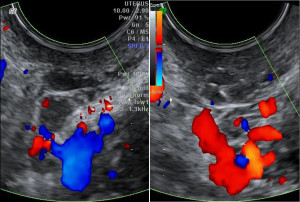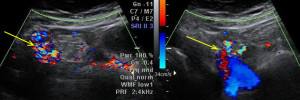Trans-vaginal ultrasound (TVU) is a way of assessing the pelvic veins. It should be performed in women when a reflux source is suspected arising from above the sapheno-femoral junction (SFJ). Approximately a sixth of women have saphenous vein reflux fed from above. Source points of pelvic venous reflux (PVR) or incompetence (PVI) include the internal iliac vein and the ovarian veins. These feed the ovarian, uterine and rectal venous plexus. Escape points into the leg are usually along the inguinal, obturator or perineal region. Accurate evaluation of all reflux sources and escape points is essential to direct durable treatment options. Reconciling pelvic venous reflux with varicose veins and pelvic venous congestion (PVC) syndrome is a grossly under researched area.
DEVENDRA DEKIWADIA An abnormal distribution of varicose veins in post partum women raises the clinical suspicion of pelvic vein incompetency (PVI). These veins are seen usually in postero-lateral thigh, gluteal, vulval and supra-pubic regions. Irrespective of whether the SFJ is refluxing or not, the veins described above could have a connection with pelvic veins which are refluxing. The identification and assessment of PVI using TVU provides important diagnostic information. Furthermore, since the test is non-invasive, it may provide a useful screening test for the presence of PVI.
A Valsalva manoeuvre to invoke an abdominal pressure change is the classical test needed to identify PVI. However, many patients do not understand how to undertake the test which makes it difficult to perform. A better alternative is to ask the patient to cough. This invokes sufficient change in intra abdominal pressure so that the flow reversal can be detected in the pelvic veins. The procedure requires positioning of the trans-vaginal US probe in the lying down position with a repetition of the manoeuvre in the standing position. This will provide the maximum information. Although the individual veins cannot be named, the presence of reflux provides sufficient evidence for further investigation and imaging, including contrast venography.
Trans-vaginal ultrasound with a patient standing. Normal breathing (left). Cough manoeuvre (right). Reflux is identified by the red colour on colour flow.
Trans-vaginal ultrasound with a patient supine. Normal breathing (left). Cough manoeuvre (right). Reflux is identified in a single vein demonstrated in red on colour flow (arrows).

